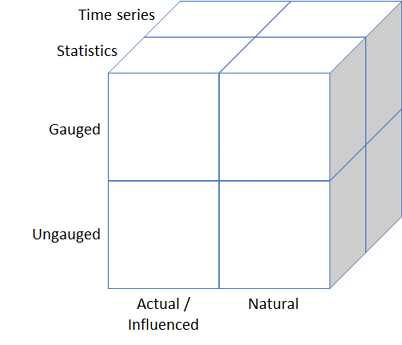Qube
River flow estimation in three dimensions:
- From gauged to ungauged catchments.
- From natural river flows to actual river flows incorporating the influence of abstractions, discharges and impounding reservoirs within catchments.
- From mean flows and flow duration curve statistics to daily time series.
Using Qube, you can:
- Define catchment boundaries (over 0.1 km²) and get key catchment characteristics.
- Estimate annual and monthly mean flows and flow duration curve statistics.
- Estimate daily flow time series.
- Interrogate catchment artificial influences.
- Incorporate and review local gauged data.
- Produce Residual Flow Diagram charts and maps.
- Export tables of flows and artificial influences, charts, maps and catchment shapefiles.
- Explore the rich mapping interface and search by place, catchment and feature names or grid references.
Please note that artificial influences, gauge details and residual flow diagrams are only visible to regulator users due to data rights.
Qube is the evolution of the LowFlows Enterprise modelling system to move beyond the estimation of natural and influenced flow statistics. The vision for Qube was the seamless modelling of flow statistics and time series anywhere, with the only distinction being the difference in accuracy between gauged and ungauged catchments. The incorporation of generalised time series models builds on 25 years of research and implementation by Wallingford HydroSolutions.
Qube was developed by Wallingford HydroSolutions in partnership with the Environment Agency.
The Requirement
The UK has a gauging station network of around 1500 permanent long term flow measurement stations measuring river flows at every 15 minutes: a challenging job in an environment where the highest flows may be 10,000 times larger than the lowest flows. For water resources, the information captured in this time series of river flows may be used directly for reservoir design or for understanding the relationships between changes in river flow and changes in instream ecology. More commonly the daily variation in flows is summarised as a flow duration curve. This enables practitioners to estimate for how much of the time a particular flow is equalled or exceeded.
There are over half a million river catchments in the UK and thus only a small fraction of these are gauged, typically the larger ones. Additionally, the natural relationship between rainfall and river flows is modified in the majority of UK rivers by the activities of man. These include abstraction for water supply, agriculture and industry, the storage of water for similar purposes and the return and dilution of used water through sewage treatment plants and industrial discharges.
Information on river flows, both natural and influenced, is central for the regulation of water use and the majority of requests are for estimates in ungauged catchments. Qube meets this requirement for flow duration curve analysis at both ungauged and gauged locations. In Qube we have incorporated new modelling functionality to enable the full time series of river flows, both natural and influenced to be estimated for any catchment.
The Qube Concept
River flow estimation in Qube can be conceptualised as a cube comprising 8 sub-cubes, each representing the river flow estimation requirement:
- Gauged actual (influenced) time series.
- Gauged actual (influenced) statistics.
- Gauged naturalised (natural) time series.
- Gauged naturalised (natural) statistics.
- Ungauged natural time series.
- Ungauged natural statistics.
- Ungauged influenced (actual) time series.
- Ungauged influenced (actual) statistics.
